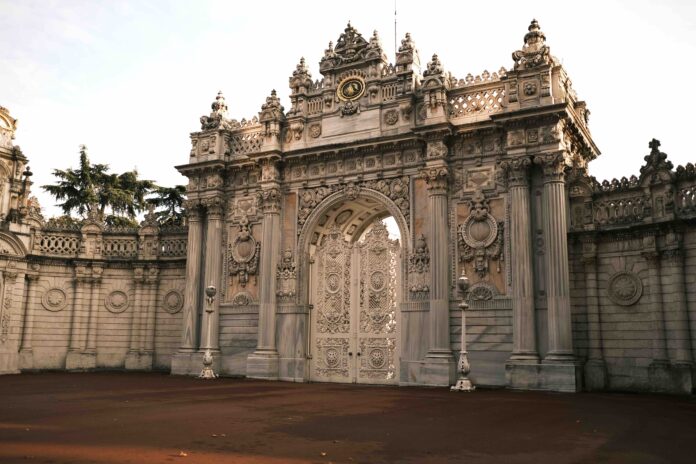Dolmabahçe Palace: A Historical Landmark in Istanbul
As one of the most impressive historical sites in Istanbul, Dolmabahçe Palace draws visitors from all over the world who come to marvel at its grandeur and learn about its rich history. The palace has served as a symbol of Ottoman opulence and power since it was commissioned by Sultan Abdulmecid I in the mid-19th century. It is located on the Bosphorus Strait, which separates Europe from Asia and has long been an important trade route connecting east and west.
The palace served as the administrative center of the Ottoman Empire, where sultans held court and conducted official business. The architectural style of Dolmabahçe Palace reflects a fusion of Ottoman and European influences, with features such as a grand entrance hall that resembles that of a European chateau, but with ornate detailing characteristic of Ottoman design.
Visitors will be struck by the elaborate furnishings throughout the palace, which include crystal chandeliers, gold leaf accents, and intricate tiles. Today, Dolmabahçe Palace is a museum that offers visitors an immersive experience into Turkish history through its many rooms filled with original furniture, art pieces and artefacts including an extensive collection of paintings.
The gardens surrounding the palace are also worth exploring; they are home to several fountains and statues from different eras. All who visit this grand monument leave with an appreciation for Turkey’s past and cultural heritage.
Step by Step Guideline About Dolmabahçe Palace
History of Dolmabahçe Palace
The Commissioning of the Palace
Dolmabahçe Palace was commissioned by Sultan Abdulmecid I in the mid-19th century. It was built as a replacement for Topkapı Palace, which had served as the primary residence for Ottoman sultans for centuries. The sultan wanted a new palace that would reflect the changing times and better accommodate his growing family and modern administrative needs.
The Significance of its Location
One of the reasons why Dolmabahçe Palace is so important is because of its location on the Bosphorus Strait. The palace sits on the European side of Istanbul and overlooks the strait, providing stunning views of both Europe and Asia. This location made it an ideal spot for trade and commerce throughout history.
Administrative Center of the Ottoman Empire
Another reason why Dolmabahçe Palace is historically significant is because it served as the administrative center of the Ottoman Empire. Many important meetings and decisions were made within these walls, including negotiations with foreign powers, signing treaties, and hosting state events. Dolmabahçe Palace has a rich history that spans several centuries.
It was commissioned by Sultan Abdulmecid I in order to provide a more modern residence for Ottoman sultans while also accommodating their growing families and administrative needs. Its location overlooking the Bosphorus Strait made it an important center for trade and commerce throughout history, while its role as an administrative center meant that many important decisions were made within its walls.
The Opulence of Dolmabahçe Palace Architecture and Design
There are few buildings in the world that can rival the grandeur and beauty of Dolmabahçe Palace. Commissioned by Sultan Abdulmecid I in the mid-19th century, it is a stunning example of Ottoman and European architectural fusion.
The palace is situated on the Bosphorus Strait, where it dominates the Istanbul skyline with its imposing façade and intricate details. The architecture of Dolmabahçe Palace incorporates elements from a variety of different styles, including Baroque, Rococo, and Neoclassical.
The result is a unique blend that creates an awe-inspiring visual spectacle. From its ornate exterior to its lavish interiors, every inch of the palace exudes luxury and elegance.
The Beauty Within
Perhaps nowhere is this more apparent than in the interior design of Dolmabahçe Palace. Crystal chandeliers hang from soaring ceilings, casting sparkling light across gilded surfaces and intricate woodwork. Gold leaf accents add an extra layer of opulence to already-rich rooms.
Visitors to the palace are immediately struck by its grandeur as they walk through room after room filled with priceless art pieces and furnishings from around the world. The Ceremonial Hall alone features a 37-meter-long carpet woven by Hereke artisans using silk fibers so fine they needed 10 people to weave one centimeter.
The Gardens
The grounds surrounding Dolmabahçe Palace are equally impressive. The sprawling gardens are filled with fountains, illuminated gardens at nightfall while fish swim in pools below them; waiting their feeding time with visitors walking under hanging flower baskets.
From vibrant flowers to lush greenery, every inch has been carefully tended to create a truly enchanting ambience. It’s hard to imagine a more beautiful setting in which to spend an afternoon strolling.
Overall, Dolmabahçe Palace is a true masterpiece of architectural design and opulence, and its beauty is sure to take your breath away. Whether you’re interested in history or simply appreciate stunning aesthetics, this landmark should be on every traveler’s must-see list.
Notable Features and Rooms
The Ceremonial Hall
One of the most impressive features of Dolmabahçe Palace is the Ceremonial Hall. This grand space was used for state events and receptions, such as diplomatic meetings or celebrations for special occasions. The hall is truly breathtaking in its size and opulence, boasting a ceiling that reaches almost 36 meters high.
It’s hard not to feel awe-struck by the sheer grandeur of the space as you stand inside it. The hall is decorated with intricate designs, including ornate chandeliers and beautifully detailed frescoes on the ceiling.
Visitors can also admire the exquisite parquet flooring, which was made using a variety of rare woods from around the world. If you’re lucky enough to visit Dolmabahçe Palace during a tour, be sure to take some time to appreciate this magnificent space.
The Crystal Staircase
Another impressive feature of Dolmabahçe Palace is the Crystal Staircase. As its name suggests, this beautiful staircase is crafted entirely from Baccarat crystal, making it both stunningly beautiful and incredibly unique. The staircase spans two floors and glimmers in the light that shines through the palace’s many windows.
Visitors can’t walk on or touch the crystal staircase due to its delicate nature, but it’s still worth admiring from afar. It’s one of those rare architectural marvels that you’re likely to remember long after your visit has ended.
The Harem Section
No visit to Dolmabahçe Palace would be complete without exploring the Harem section of the palace. This area was where Sultan Abdulmecid I and his family lived during their time at Dolmabahçe Palace.
Visitors can get a glimpse into what life was like for the Sultan and his family by exploring the various rooms in this section of the palace. The Harem contains a number of beautifully decorated rooms, including living areas, bedrooms, and baths.
You can see firsthand how the Sultan’s family lived during their time at the palace and get a sense of what their daily routine might have been like. It’s a fascinating glimpse into history that’s not to be missed.
Famous Visitors to Dolmabahçe Palace
Winston Churchill’s Stay in 1945
One of the most famous visitors to Dolmabahçe Palace was the former British Prime Minister, Winston Churchill. After the end of World War II, Churchill visited Istanbul in 1945 to meet with President Franklin D. Roosevelt and Soviet leader Joseph Stalin for a conference on post-war Europe. During his stay, he was invited to stay at Dolmabahçe Palace as a guest of Turkish President İsmet İnönü.
Churchill stayed in one of the palace’s most luxurious rooms, which had hosted many other famous guests before him. He described his room as having “brown paneled walls and ceiling, white marble fireplaces at either end and an immense bed.” During his stay, he met with Turkish officials and even gave a speech from the balcony overlooking the Bosphorus Strait.
Other Notable Visitors
In addition to Churchill’s visit, Dolmabahçe Palace has hosted many other notable visitors throughout its history. Queen Elizabeth II visited in 2008 during her state visit to Turkey and was given a tour of the palace by Turkish President Abdullah Gül.
King Farouk of Egypt also stayed at Dolmabahçe Palace during his exile in 1952. Perhaps one of the most significant visitors to Dolmabahçe Palace was Mustafa Kemal Atatürk, who used the palace as his residence during his visits to Istanbul between 1927 and 1938.
Atatürk is considered one of Turkey’s greatest leaders for leading its transformation from an Ottoman Empire into a modern republic. His presence at Dolmabahçe Palace adds another layer of historical significance to this already impressive landmark.
Overall, these visitors give a sense of the palace’s importance not only to Turkey but also on an international level. Their visits attest to the significance of Dolmabahçe Palace as a cultural and historical treasure that should be preserved for future generations.
Restoration Efforts
How the Palace has been Restored over Time
Over the years, Dolmabahçe Palace has undergone several rounds of restoration efforts to maintain its structural integrity and preserve its historical significance. The first major restoration took place in 1927, led by architect Arif Hikmet Koyunoğlu.
This project focused on repairing damages caused by earthquakes and fires, as well as upgrading the electrical and plumbing systems. In the 1980s, a second wave of renovations began that aimed to restore the palace’s interiors to their original grandeur.
This effort included restoring damaged artwork, repairing furniture, and refurbishing textiles. The main objective was to make sure visitors could experience the opulence of Ottoman-era luxury when visiting.
Most recently, in 2016, a three-year-long restoration was completed on Dolmabahçe’s roof and façade. With funding from Turkey’s Ministry of Culture and Tourism, workers repaired cracks in walls and columns as well as restored decorative elements such as windowsills and shutters.
Opportunities for Future Restoration
Despite these efforts at preserving the palace’s beauty for future generations to come, there is still much work that needs to be done. Funding is one ongoing issue facing Dolmabahçe Palace’s caretakers; a UNESCO report noted that there wasn’t proper support or funds allocated for preserving many important landmarks throughout Istanbul.
Another challenge lies in understanding how best to approach restorations without detracting from historical authenticity – what should be left untouched versus updated? The answer isn’t always clear-cut or simple.
Conclusion
Dolmabahçe Palace stands as an important testament to Istanbul’s rich history surrounding Ottoman rule. Through architectural innovation fused with refined Ottoman tradition within its design elements this palace is a must-visit for tourists.
With ongoing efforts to restore and preserve its iconic structure, the palace remains an important landmark for future generations to enjoy. A visit to Dolmabahçe Palace is more than just an aesthetic pleasure; it’s a way of connecting with history and understanding how Istanbul has evolved throughout centuries.



